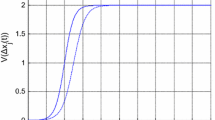Abstract
This paper extends a non-local second order continuum traffic model to take into account the timid or aggressive driver behaviours. Based on the proposed model, we derive analytically the effect of timid or aggressive driver behaviours on the instability of traffic dynamics. Simulation results are presented to show how the timid or aggressive driver behaviours influence the formation and dissipation of stop-and-go waves. It is found theoretically and numerically that aggressive drivers tend to stabilize traffic flow whereas timid drivers tend to destabilize traffic flow.
Similar content being viewed by others
References
Brackstone, M., McDonald, M.: Car-following: A historical review. Transp. Res., Part F 2, 181–196 (2000)
Daganzo, C.F.: The cell transmission model, part II: network traffic. Transp. Res., Part B, Methodol. 28, 279–293 (1994)
Daganzo, C.F.: Requiem for second-order fluid approximations of traffic flow. Transp. Res., Part B, Methodol. 29, 277–286 (1995)
Helbing, D.: Improved fluid-dynamic model for vehicular traffic. Phys. Rev. E 51, 3164–3169 (1995)
Helbing, D.: Gas-kinetic derivation of Navier–Stokes-like traffic equations. Phys. Rev. E 53, 2366–2381 (1996)
Helbing, D., Johansson, A.F.: On the controversy around Daganzo’s requiem for and Aw–Rascle’s resurrection of second-order traffic flow models. Eur. Phys. J. B 69, 549–562 (2009)
Helbing, D., Treiber, M.: Gas-kinetic based traffic flow models explaining observed hysteretic phase transition. Phys. Rev. Lett. 81, 3042–3045 (1998)
Helbing, D., Hennecke, A., Shvetsov, V., Treiber, M.: MASTER: macroscopic traffic simulation based on a gas-kinetic non-local traffic model. Transp. Res., Part B, Methodol. 35(2), 183–211 (2001)
Hoogendoorn, S.P., Bovy, P.H.L.: Multiclass macroscopic traffic flow modelling: a multilane generalization using gas-kinetic theory. In: Proceedings of the 14th International Symposium on Transportation and Traffic Theory, Jarusalem, Israel, pp. 27–50 (1999)
Hoogendoorn, S.P., Bovy, P.H.L.: Generic gas-kinetic traffic systems modeling with applications to vehicular traffic flow. Transp. Res., Part B, Methodol. 35, 317–336 (2001)
Hoogendoorn, S.P., Bovy, P.H.L., van-Lint, H.: Short-term prediction of traffic flow conditions in a multilane multi-class network. In: Transportation and Traffic Theory in the 21st Century, pp. 625–651 (2002)
Kerner, B.S., Konhauser, P., Schilke, M.: Deterministic spontaneous appearance of traffic jam in slightly inhomogeneous traffic flow. Phys. Rev. E 51, R6243–R6246 (1995)
Kesting, A., Treiber, M.: How reaction time, update time, and adaptation time influence the stability of traffic flow. Comput.-Aided Civ. Infrastruct. Eng. 23, 125–137 (2008)
Klar, A., Wegener, R.: Enskog-like kinetic models for vehicular traffic. J. Stat. Phys. 87, 91–114 (1997)
Laval, J.A.: Hysteresis in traffic flow revisited: An improved measurement method. Transp. Res., Part B, Methodol. 45, 385–391 (2011)
Laval, J.A., Leclercq, L.: A mechanism to describe the formation and propagation of stop-and-go waves in congested freeway traffic. Philos. Trans. R. Soc. Lond. A 368, 4519–4541 (2011)
Lebacque, J.P.: First order macroscopic traffic flow models: intersection modeling, network modeling. In: Proceedings of the 16th International Symposium on Transportation and Traffic Theory, College Park, MD, USA, pp. 365–386 (2005)
Lighthill, M.H., Whitham, G.B.: On kinematic waves 2: A theory of traffic flow on long, crowded roads. Proc. R. Soc. Lond. A 229, 317–345 (1955)
Nelson, P.: A kinetic theory of vehicular traffic and its associated bimodal equilibrium solutions. Transp. Theory Stat. Phys. 24, 383–409 (1995)
Ngoduy, D.: Operational effects of acceleration lane on main traffic flow at discontinuities. Transportmetrica 4, 195–207 (2008)
Ngoduy, D.: Application of gas-kinetic theory to modelling mixed traffic of manual and adaptive cruise control vehicles. Transportmetrica 8, 43–60 (2012)
Ngoduy, D.: Multiclass first order modelling of traffic networks using discontinuous flow-density relationships. Transportmetrica 6, 121–141 (2010)
Ngoduy, D.: Multiclass first-order traffic model using stochastic fundamental diagrams. Transportmetrica 7, 111–125 (2011)
Ngoduy, D., Liu, R.: Multiclass first order simulation model to explain non-linear traffic phenomena. Physica A 385, 667–682 (2007)
Ngoduy, D., Tampere, C.M.J.: Macroscopic effects of reaction time on traffic flow characteristics. Phys. Scr. 80, 025802 (2009)
Ngoduy, D., Hoogendoorn, S.P., Liu, R.: Continuum traffic flow modelling of cooperative traffic systems. Physica A 388, 2705–2716 (2009)
Olmos, L.E., Munoz, J.D.: A cellular automaton model for the traffic floow in Bogota. Int. J. Mod. Phys. C 15, 1397–1411 (2004)
Paveri-Fontana, S.L.: On Boltzmann-like treatments for traffic flow: a critical review of the basic model and an alternative proposal for dilute traffic analysis. Transp. Res., Part B, Methodol. 9, 225–235 (1975)
Payne, H.J.: Models for freeway traffic control. In: Mathematical Models of Public Systems, vol. 1, pp. 51–61 (1971)
Philips, W.F.: Kinetic model for traffic flow with continuum implications. Transp. Res. Plan. Technol. 5, 131–138 (1979)
Prigogine, I., Andrews, F.C.: A Boltzmann-like approach for traffic flow. Oper. Res. 8, 789–797 (1960)
Richards, P.I.: Shock waves on the highway. Oper. Res. 4, 42–51 (1956)
Schonhof, M., Helbing, D.: Empirical features of congested traffic states and their implications for traffic modeling. Transp. Sci. 41, 135–166 (2007)
Treiber, M., Helbing, D.: Macroscopic simulation of widely scattered synchronized traffic states. J. Phys. A, Math. Gen. 32, L17–L23 (1999)
Treiber, M., Kesting, A.: Verkehrsdynamik und -simulation, pp. 226–230. Springer, Berlin (2010)
Treiber, M., Hennecke, A., Helbing, D.: Derivation, properties and simulation of a gas-kinetic-based, non-local traffic model. Phys. Rev. E 59, 239–253 (1999)
Treiber, M., Kesting, A., Helbing, D.: Three-phase traffic theory and two-phase models with a fundamental diagram in the light of empirical stylized facts. Transp. Res., Part B 44, 983–1000 (2010)
Wong, G.C.K., Wong, S.C.: A multiclass traffic flow model–an extension of LWR model with heterogeneous drivers. Transp. Res., Part A 36, 763–848 (2002)
Zhang, P., Wong, S.: Essence of conservation forms in the travelling waves solutions of higher order traffic models. Phys. Rev. E 74, 026109 (2006)
Author information
Authors and Affiliations
Corresponding author
Rights and permissions
About this article
Cite this article
Ngoduy, D. Effect of driver behaviours on the formation and dissipation of traffic flow instabilities. Nonlinear Dyn 69, 969–975 (2012). https://doi.org/10.1007/s11071-011-0318-6
Received:
Accepted:
Published:
Issue Date:
DOI: https://doi.org/10.1007/s11071-011-0318-6




